

In Part 1 and Part 2 I shared my experiences preparing and moving my little observatory to its new home in Colfax, IA. After several work days of preparation spread over many weeks, Bryan Healy and I safely towed the observatory on Bryan’s car trailer to its new location on a knoll overlooking a creek valley. I mentioned last month that there would be no crane waiting to unload the building from trailer. Getting a crane to the site and back out proved much too expensive (I could have rebuilt the observatory for less!). Bryan had an alternate plan...
There was still a few hours of daylight left when we arrived at the observatory site. Bryan planned to use two hydraulic jacks to raise the building vertically off the trailer. We would then use cribbing to hold the building’s weight while we pulled the trailer out from under it. Bryan explained that our project’s cribbing would consist of stacked layers of 4x4 inch lumber (see illustration at left) under each of the building’s four corners. The stacks would make a very sturdy and stable support system.
The first challenge was the slope of the ground where the trailer rested. The hitch end by the pickup was nearly touching the ground. The rear end was close to 30” above the ground. We realized quickly that we’d need to locate more lumber for cribbing. After thinking our work for the day would be cut short, I remembered my wife’s “honey do list”. Wrapping around the garage was a dilapidated garden bed she wanted removed. The bed was contained by — you guessed it — 4x4 landscaping timbers! Tossing aside my ambivalence towards starting on the “honey do list”, I tore into the timbers destroying what was left of the beds. With a chainsaw and about an hour’s effort we manufactured an ample supply of cribbing.
The lifting process was unexpectedly slow going. Extracting the trailer took the remainder of day 1 and most of the following day. We started by inserting two 4x6 beams perpendicular to the beams used to hoist the building onto the trailer. Where the trailer was low to the ground we actually hung the building from the beam using log chains. This gave us more height to safely work the jacks and cribbing. The chains also secured the beam from rolling and toppling the works. Rolling off the support beam was a bigger concern at the other end where the 4x6 beam was underneath the structure. To prevent problems there Bryan fixed a shorter length of beam with large C-clamps effectively making a 6x6 square beam that would not roll. The arrangement worked nicely.
At one point we experienced a bit of a scare. While lifting the building it became unbalanced and suddenly pivoted about 5 degrees. I remember grabbing the support beam near me as if I could have stopped it. The building’s weight landed firmly on the cribbing which held firm (cribbing is very sturdy engineering!). The lesson learned: take a break and then take it slower. Another important lesson we learned was 3-points are more stable than 4. During the early stages of the lifting process we raised the building corner by corner. This in fact led to the building’s sudden unexpected rotation. Bryan considered this problem and realized we should raise the building from the center of the support beams. By doing so, two corners would always be in solid contact with the cribbing. This also meant the hydraulic jack had to be centered and as vertical as possible during the lifting process.
At one point we experienced a bit of a scare. While lifting the building it became unbalanced and suddenly pivoted about 5 degrees. I remember grabbing the support beam near me as if I could have stopped it. The building’s weight landed firmly on the cribbing which held firm (cribbing is very sturdy engineering!). The lesson learned: take a break and then take it slower. Another important lesson we learned was 3-points are more stable than 4. During the early stages of the lifting process we raised the building corner by corner. This in fact led to the building’s sudden unexpected rotation. Bryan considered this problem and realized we should raise the building from the center of the support beams. By doing so, two corners would always be in solid contact with the cribbing. This also meant the hydraulic jack had to be centered and as vertical as possible during the lifting process.
The next morning (Monday) I took numerous pictures to document the previous day’s efforts. Bryan and I decided to take “vacation” days to get the building on the ground. At midmorning we were at it again. After a couple hours we lowered the building to a level where we could no longer use the hydraulic jacks. Bryan suggested using my small farm tractor’s loader bucket to complete the work. I was sure the building’s weight would tip the tractor forward but it didn’t. The tractor was able to raise the load only a few inches but it was enough to continue the removing of the cribbing. Working with the tractor we were able to finish up in another hour or so. I couldn’t thank Bryan enough for all his help. I urged him home to enjoy what was left of his day off.
At this writing I can look out the window and see my little building snowed in down the hill. My telescope and mount are in the basement. The heavy pier and dome are in the garage. And I’m indebted to the “Honey Do List”. I’m eager for spring to arrive!